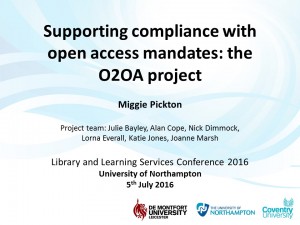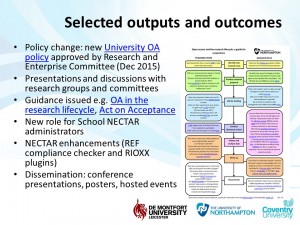Miggie Pickton
Download: PDF / Powerpoint
 ‘Open Access’ (OA) is no longer the province of an enthusiastic few but now has a leading role to play in scholarly communications. This change has in no small part been driven by an increasing expectation by research funders that the outputs they support should be made OA. In particular, HEFCE’s announcement that “journal articles and conference proceedings must be available in an open-access form to be eligible for the next REF” (HEFCE, 2015) has galvanised the sector into engaging with OA.
‘Open Access’ (OA) is no longer the province of an enthusiastic few but now has a leading role to play in scholarly communications. This change has in no small part been driven by an increasing expectation by research funders that the outputs they support should be made OA. In particular, HEFCE’s announcement that “journal articles and conference proceedings must be available in an open-access form to be eligible for the next REF” (HEFCE, 2015) has galvanised the sector into engaging with OA.
The Open to Open Access (O2OA) project was one of nine projects in the Jisc’s Open Access Good Practice Pathfinder programme. It aimed to develop processes, technical solutions and guidance to support university researchers in complying with institutional and funder open access mandates.
Three East Midlands universities: Coventry, De Montfort and Northampton, worked collaboratively on the O2OA project. All three are teaching led, ‘modern’ universities and have an interest in increasing their research profile, but all have limited budgets with which to achieve this. The project therefore focused on ways of enabling compliance without additional resource.
Beginning with a round of focus groups and interviews, the project partners sought to establish researchers’ understanding and needs with respect to OA. Questions covered the drivers of OA, publishing routes, perceived benefits and deterrents, and the institutional mechanisms and support available to researchers. The results evidenced a wide range of knowledge and understanding of OA matters among researchers and highlighted areas for further action.
 In considering further action, the project team recognised that knowing the benefits of OA, and even the sanctions for non-compliance, might not be sufficient to persuade people to change their behaviour. The project leader, Julie Bayley, therefore proposed an intervention mapping approach, based on behaviour change theory, to enable research support staff to better understand the components of each problem and the most appropriate solutions to address these (Bayley, 2015).
In considering further action, the project team recognised that knowing the benefits of OA, and even the sanctions for non-compliance, might not be sufficient to persuade people to change their behaviour. The project leader, Julie Bayley, therefore proposed an intervention mapping approach, based on behaviour change theory, to enable research support staff to better understand the components of each problem and the most appropriate solutions to address these (Bayley, 2015).
The problems identified, the solutions and the lessons learned formed the basis of a shared learning log in which the three project partners were able to compare their experiences and share good practice both among themselves and more widely across the sector.
This work has underpinned changes to policy, process, workflow and guidance at Northampton. The University’s new OA policy enables researchers to meet HEFCE’s and other funders’ OA requirements even without additional funding. The repository workflow has been fine-tuned to support the new policy and researchers are now aware of how they may reap the benefits of OA at all stages of the research lifecycle.
Bayley, J. (2015) Strengthening OA practice: Using intervention logic to support drives for change [online]. Available from: http://blogs.coventry.ac.uk/researchblog/wp-content/uploads/sites/5/2015/10/O2OA-Intervention-mapping-output-Oct-15.pdf [accessed 11/05/16].
